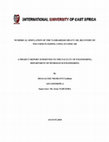Papers by Guillain S H A G A L U K E Nkoranyi
Data file used for research proposal whereby polymer injection was used as recovery method to swe... more Data file used for research proposal whereby polymer injection was used as recovery method to sweep heavy oil from a reservoir.
Drafts by Guillain S H A G A L U K E Nkoranyi
Safety is the key factor allowing companies to operate efficiently and without danger on the work... more Safety is the key factor allowing companies to operate efficiently and without danger on the worker. The unsafe act and unsafe conditions are the main causes of accidents which may result into a minor or major fires, harms and other consequences. After the accident, the company may suffer from loss of production and profit and that is very dangerous as known in the rules of each company.
Thesis Chapters by Guillain S H A G A L U K E Nkoranyi

My BSc degree thesis, 2018
Nowadays various recovery mechanisms are used in the petroleum industry to increase hydrocarbon p... more Nowadays various recovery mechanisms are used in the petroleum industry to increase hydrocarbon production as much as possible in a given oil and gas field. Water flooding being the main technology used, it recovers 10 to 40 percent of the oil in place. Many factors are causes of this low recovery percentage that can be the fingering effect etc. The remaining oil in the reservoir can be divided into two categories that are: the remaining oil beyond water flooding process and bypassed oil.
The purpose of this research is to examine the efficiency of polymer flooding compared to water flooding, examine the effect of oil viscosity change due to change in reservoir pressure and temperature, and make a proper choice of polymer concentration for better oil recovery for the Tambaredjo oil field by doing simulation on the black oil reservoir model.
Firstly, water flooding was simulated, and various cases were investigated such as water injection rate and well pattern. The five spots well pattern has given a higher recovery compared to two spots and nine spots well patterns. And the water injection rate of 22,000Stb/Day has given better recovery compared to 11,000Stb/Day, 15,000Stb/Day, 20,000Stb/Day and 22,000Stb/Day. Thus, the five spots well pattern and 22,000Stb/Day were used in the second step which is polymer flooding.
Secondly, polymer flooding was simulated and various values of polymer concentration were set. The better polymer concentration was 22lb/bbl because it has given a better oil recovery compared to 2lb/bbl, 6lb/bbl, 10lb/bbl,14lb/bbl and 18lb/bbl.
Thirdly, an examination of oil viscosity change was done by varying the reservoir oil viscosities in the oil PVT table. This case helped to understand the effect of reservoir pressure and temperature change that affect reservoir oil viscosity and thus affect also the oil recovery.
The oil recovery increased from 16% (case of water flooding) to 24.5% (case of polymer flooding). This allows us to conclude that with the reservoir model on which the study was done, polymer flooding is not favorable for the Tambaredjo oil field. But this last sentence would be validated after performing one of the stimulations methods to see if there will be an increase in the oil recovery from this field. A study would be undertaken to examine either one of the stimulation methods would improve the oil recovery from the Tambaredjo oil field.









Uploads
Papers by Guillain S H A G A L U K E Nkoranyi
Drafts by Guillain S H A G A L U K E Nkoranyi
Thesis Chapters by Guillain S H A G A L U K E Nkoranyi
The purpose of this research is to examine the efficiency of polymer flooding compared to water flooding, examine the effect of oil viscosity change due to change in reservoir pressure and temperature, and make a proper choice of polymer concentration for better oil recovery for the Tambaredjo oil field by doing simulation on the black oil reservoir model.
Firstly, water flooding was simulated, and various cases were investigated such as water injection rate and well pattern. The five spots well pattern has given a higher recovery compared to two spots and nine spots well patterns. And the water injection rate of 22,000Stb/Day has given better recovery compared to 11,000Stb/Day, 15,000Stb/Day, 20,000Stb/Day and 22,000Stb/Day. Thus, the five spots well pattern and 22,000Stb/Day were used in the second step which is polymer flooding.
Secondly, polymer flooding was simulated and various values of polymer concentration were set. The better polymer concentration was 22lb/bbl because it has given a better oil recovery compared to 2lb/bbl, 6lb/bbl, 10lb/bbl,14lb/bbl and 18lb/bbl.
Thirdly, an examination of oil viscosity change was done by varying the reservoir oil viscosities in the oil PVT table. This case helped to understand the effect of reservoir pressure and temperature change that affect reservoir oil viscosity and thus affect also the oil recovery.
The oil recovery increased from 16% (case of water flooding) to 24.5% (case of polymer flooding). This allows us to conclude that with the reservoir model on which the study was done, polymer flooding is not favorable for the Tambaredjo oil field. But this last sentence would be validated after performing one of the stimulations methods to see if there will be an increase in the oil recovery from this field. A study would be undertaken to examine either one of the stimulation methods would improve the oil recovery from the Tambaredjo oil field.
The purpose of this research is to examine the efficiency of polymer flooding compared to water flooding, examine the effect of oil viscosity change due to change in reservoir pressure and temperature, and make a proper choice of polymer concentration for better oil recovery for the Tambaredjo oil field by doing simulation on the black oil reservoir model.
Firstly, water flooding was simulated, and various cases were investigated such as water injection rate and well pattern. The five spots well pattern has given a higher recovery compared to two spots and nine spots well patterns. And the water injection rate of 22,000Stb/Day has given better recovery compared to 11,000Stb/Day, 15,000Stb/Day, 20,000Stb/Day and 22,000Stb/Day. Thus, the five spots well pattern and 22,000Stb/Day were used in the second step which is polymer flooding.
Secondly, polymer flooding was simulated and various values of polymer concentration were set. The better polymer concentration was 22lb/bbl because it has given a better oil recovery compared to 2lb/bbl, 6lb/bbl, 10lb/bbl,14lb/bbl and 18lb/bbl.
Thirdly, an examination of oil viscosity change was done by varying the reservoir oil viscosities in the oil PVT table. This case helped to understand the effect of reservoir pressure and temperature change that affect reservoir oil viscosity and thus affect also the oil recovery.
The oil recovery increased from 16% (case of water flooding) to 24.5% (case of polymer flooding). This allows us to conclude that with the reservoir model on which the study was done, polymer flooding is not favorable for the Tambaredjo oil field. But this last sentence would be validated after performing one of the stimulations methods to see if there will be an increase in the oil recovery from this field. A study would be undertaken to examine either one of the stimulation methods would improve the oil recovery from the Tambaredjo oil field.